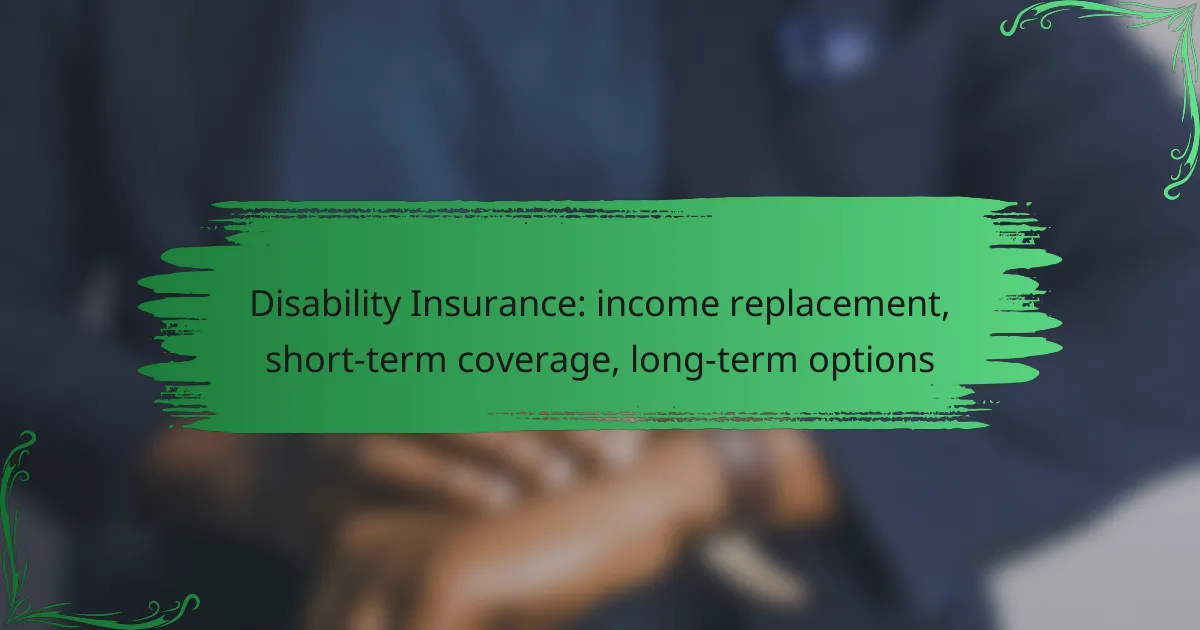Disability insurance is essential for providing income replacement when individuals are unable to work due to illness or injury. It encompasses various options, including short-term and long-term coverage, each tailored to meet specific needs. Understanding these features can guide you in selecting the most suitable policy to ensure financial stability during challenging times.

What are the best disability insurance options in the UK?
The best disability insurance options in the UK include income replacement insurance, short-term disability coverage, and long-term disability insurance. Each type serves different needs, so understanding their features can help you choose the right policy for your situation.
Income replacement insurance
Income replacement insurance provides financial support if you are unable to work due to a disability. Typically, it covers a percentage of your income, often ranging from 50% to 80%, depending on the policy. This type of insurance is crucial for maintaining your standard of living during periods of incapacity.
When selecting income replacement insurance, consider factors such as the waiting period before benefits begin and the duration of coverage. Some policies may have a cap on the total payout, so review the terms carefully to ensure adequate protection.
Short-term disability coverage
Short-term disability coverage offers temporary financial assistance for a limited period, usually up to six months. This insurance is designed to bridge the gap between the onset of a disability and the start of long-term benefits or recovery. It often pays a portion of your salary, similar to income replacement insurance.
Many employers provide short-term disability coverage as part of their benefits package. If you are considering a policy, check the waiting period and the maximum benefit duration to ensure it aligns with your needs.
Long-term disability insurance
Long-term disability insurance is intended for more serious or prolonged disabilities that prevent you from working for an extended time, often several years or until retirement age. This insurance typically provides a higher percentage of your income compared to short-term options and can last for many years.
When evaluating long-term disability insurance, pay attention to the definition of disability in the policy, as it can vary significantly. Some policies may require you to be unable to perform any job, while others may only require you to be unable to perform your specific occupation. Understanding these nuances is essential for selecting the right coverage.

How does disability insurance work?
Disability insurance provides income replacement for individuals who become unable to work due to illness or injury. It typically offers financial support during both short-term and long-term periods of disability, helping to cover essential living expenses.
Income replacement mechanism
The income replacement mechanism of disability insurance is designed to provide a portion of your salary when you cannot work. Most policies replace between 50% to 70% of your pre-disability income, ensuring you can maintain a reasonable standard of living.
Payments are usually made monthly and can be adjusted based on the policy’s terms. For example, if you earned $4,000 per month before your disability, your insurance might provide between $2,000 and $2,800 each month during your claim period.
Benefit duration and waiting periods
Benefit duration refers to how long you can receive payments from your disability insurance policy. Short-term disability coverage typically lasts from a few months up to a year, while long-term disability can extend for several years or until retirement age, depending on the plan.
Waiting periods, or elimination periods, are the time you must wait after becoming disabled before benefits begin. Common waiting periods range from 30 to 90 days. Choosing a longer waiting period can lower your premium, but it also means you will need to manage your finances without support for a longer time.

What are the eligibility criteria for disability insurance?
Eligibility for disability insurance typically depends on factors such as age, health status, and employment situation. Insurers assess these criteria to determine if an applicant qualifies for coverage and the terms of that coverage.
Age and health requirements
Most disability insurance policies have age limits for applicants, often ranging from 18 to 60 years old. Additionally, insurers require medical evaluations to assess an applicant’s health status, as pre-existing conditions can affect eligibility and premium rates.
It is essential to disclose all health information accurately, as failing to do so may result in denied claims later. Insurers may also consider lifestyle factors, such as smoking or high-risk occupations, which can influence both eligibility and coverage costs.
Employment status considerations
Your employment status plays a crucial role in qualifying for disability insurance. Insurers typically require applicants to be employed full-time or part-time, and self-employed individuals may need to provide additional documentation of income and work history.
It’s important to understand that some policies may have waiting periods before benefits kick in, especially for those who are newly employed or transitioning jobs. Ensure you review your policy’s terms regarding employment changes, as this can impact your coverage and benefits.

How to choose the right disability insurance policy?
Choosing the right disability insurance policy involves understanding your coverage needs, comparing policy features, and evaluating the terms that best fit your situation. Focus on how much income replacement you require and the duration of coverage you need, whether short-term or long-term.
Assessing coverage needs
Start by determining your monthly expenses, including housing, bills, and other obligations. This will help you identify how much income replacement you need if you become unable to work due to a disability.
Consider the length of time you might need support. Short-term disability insurance typically covers a few months, while long-term options can last for years or until retirement age. Assess your job stability and health conditions to gauge the likelihood of needing extended coverage.
Comparing policy features
When comparing disability insurance policies, look for key features such as waiting periods, benefit amounts, and the duration of payments. A shorter waiting period may mean higher premiums, but it provides quicker financial relief.
Evaluate the definitions of disability used in policies, as some may require you to be unable to perform any job, while others might only require you to be unable to perform your specific occupation. This distinction can significantly impact your benefits.

What are the costs associated with disability insurance?
The costs of disability insurance primarily include premiums, which vary based on several factors, and potential out-of-pocket expenses during the waiting period before benefits begin. Understanding these costs is essential for selecting the right policy that meets your needs.
Premium ranges in the UK
In the UK, disability insurance premiums typically range from £20 to £100 per month, depending on coverage levels and individual circumstances. Policies with higher coverage limits or shorter waiting periods generally come with higher premiums.
For example, a policy providing £1,500 monthly benefits might cost around £50 per month for a healthy individual in their 30s. However, older applicants or those with pre-existing conditions may see their premiums increase significantly.
Factors influencing pricing
Several factors influence the pricing of disability insurance, including age, occupation, health status, and the level of coverage chosen. Younger individuals often pay lower premiums due to reduced risk, while high-risk occupations may face higher costs.
Additionally, the waiting period before benefits kick in can affect pricing; shorter waiting periods typically lead to higher premiums. It’s also important to consider whether the policy includes inflation protection, as this can impact long-term costs and benefits.

What are the common exclusions in disability insurance?
Common exclusions in disability insurance typically involve conditions or situations that insurers do not cover. Understanding these exclusions is crucial for policyholders to ensure they have adequate protection when needed.
Pre-existing conditions
Pre-existing conditions refer to health issues that existed before the start of a disability insurance policy. Most insurers will not cover disabilities arising from these conditions for a specified period, often ranging from a few months to a couple of years after the policy begins.
For example, if an individual has a history of back problems and files a claim for a back-related disability shortly after purchasing a policy, that claim may be denied. It is essential to review the specific terms of the policy regarding pre-existing conditions to avoid surprises.
Self-inflicted injuries
Self-inflicted injuries are generally excluded from disability insurance coverage. This includes injuries resulting from suicide attempts or other deliberate acts that harm oneself. Insurers view these situations as avoidable and therefore not eligible for benefits.
Policyholders should be aware that if they are injured due to reckless behavior, such as substance abuse or dangerous activities, their claims may also be denied. It is advisable to read the policy carefully and understand the implications of these exclusions on potential claims.

How to file a disability insurance claim?
Filing a disability insurance claim involves submitting specific documentation to your insurer to prove your eligibility for benefits. This process typically includes completing a claim form, providing medical records, and sometimes undergoing an assessment by a medical professional.
Gather necessary documentation
Start by collecting all required documents to support your claim. This usually includes your policy details, medical records from your healthcare provider, and any relevant employment information. Ensure that your medical documentation clearly outlines your condition and how it impacts your ability to work.
Complete the claim form
Fill out the claim form provided by your insurance company accurately and thoroughly. Be honest about your condition and how it affects your daily life. Double-check for any missing information or signatures, as incomplete forms can delay the processing of your claim.
Submit your claim
Once you have completed the claim form and gathered all necessary documentation, submit your claim to your insurance provider. This can often be done online, by mail, or sometimes by fax. Keep copies of everything you send for your records and note the submission date.
Follow up on your claim
After submitting your claim, follow up with your insurance company to confirm receipt and inquire about the status. Claims can take several weeks to process, so regular communication can help ensure your claim is being handled efficiently. If your claim is denied, request a detailed explanation and consider appealing the decision if warranted.



